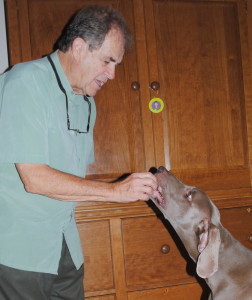Owning a dog or cat is a fairly reasonable cost, but there are some unavoidable fees involved. If you purchase an animal from a breeder or pet store, there will be a fee, often pricey. Then you may have to pay to spay or neuter your new pet. Adopting a pet from a reputable rescue or shelter usually costs much less. Often, the spay or neuter surgery and vaccinations are included in the adoption fee. Plus, you have the added benefit of knowing you saved a life!
Once the animal belongs to you, there will be the expected and unexpected veterinary bills, food, toys and other supplies. Be sure you are prepared to take care of those expenses before you bring home a new pet. Also, recognize that your new pet will grow old one day, just as you will. That dog or cat should be a valued member of your family, so that you will take good care of him during his senior years.
Our Gator is now 11 1/2 years old! His breed is prone to body masses as they age, and Gator is no exception. He has ugly tumors all over his big body. Our boy isn’t the sleek, handsome guy he used to be. But we love him just as much as when he was a stunning example of the Weimaraner breed. He is older now and needs more care and more attention from the vet. We intend to see that he receives everything he needs until he is no longer with us. He’s one of the family.

The ASPCA says that “the annual cost of pet ownership for a medium-sized dog is about $1580 each year. The cost of a cat can run just over $1,000 yearly.”
Following are some suggestions to help you save money while giving your pet a wonderful life:
- Watch your local news for notice of low-cost vaccination clinic in your area.
- Check with your area animal welfare organizations for veterinary clinics. For instance, Suncoast Humane in Englewood, FL, operates a low-cost vet clinic.
- Adopt instead of buying from a breeder or pet store. Adoption fees are nearly always cheaper than buying from a breeder. Please don’t ever buy a dog from a retail pet store because chances are, the animals come from a known puppy mill.
- Research pet food to find the healthiest food you can afford. Better pet food may cost a little more, but your pet’s better health resulting from eating quality food will keep the vet bills down.
- Save money on pet toys by making them yourself. Your dog or cat doesn’t need fancy toys that will break the budget.
- Dogs and cats like to have their own beds, but price those in retail pet stores and you may find them to be very expensive. Again, make your own.
- Take care of as many of the small pet care tasks yourself. Having the vet’s office clip your pet’s nails or clean their ears adds to the cost of the visit.
- Keep in mind when you are choosing a new dog that smaller dogs cost less to raise that large ones. Along with slightly higher veterinary bills for such things as vaccinations and medications, large dogs cost more to feed and boarding fees tend to be higher.
- When you need flea & tick & heartworm preventatives or other medications for your pet, compare the prices in various stores. We found the best values at PetCareRX.com and have ordered from them for a couple of years. You may also find that using natural preventatives for parasites is just as effective and costs less.